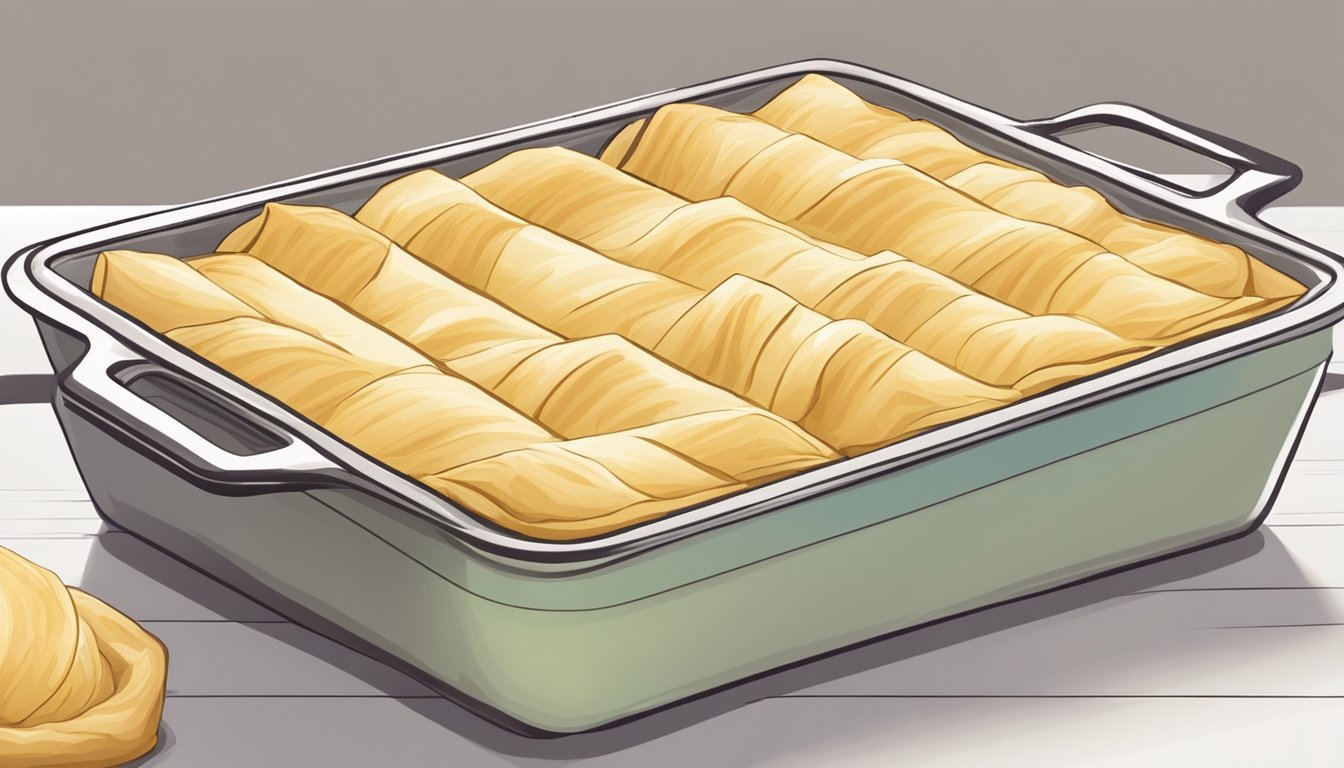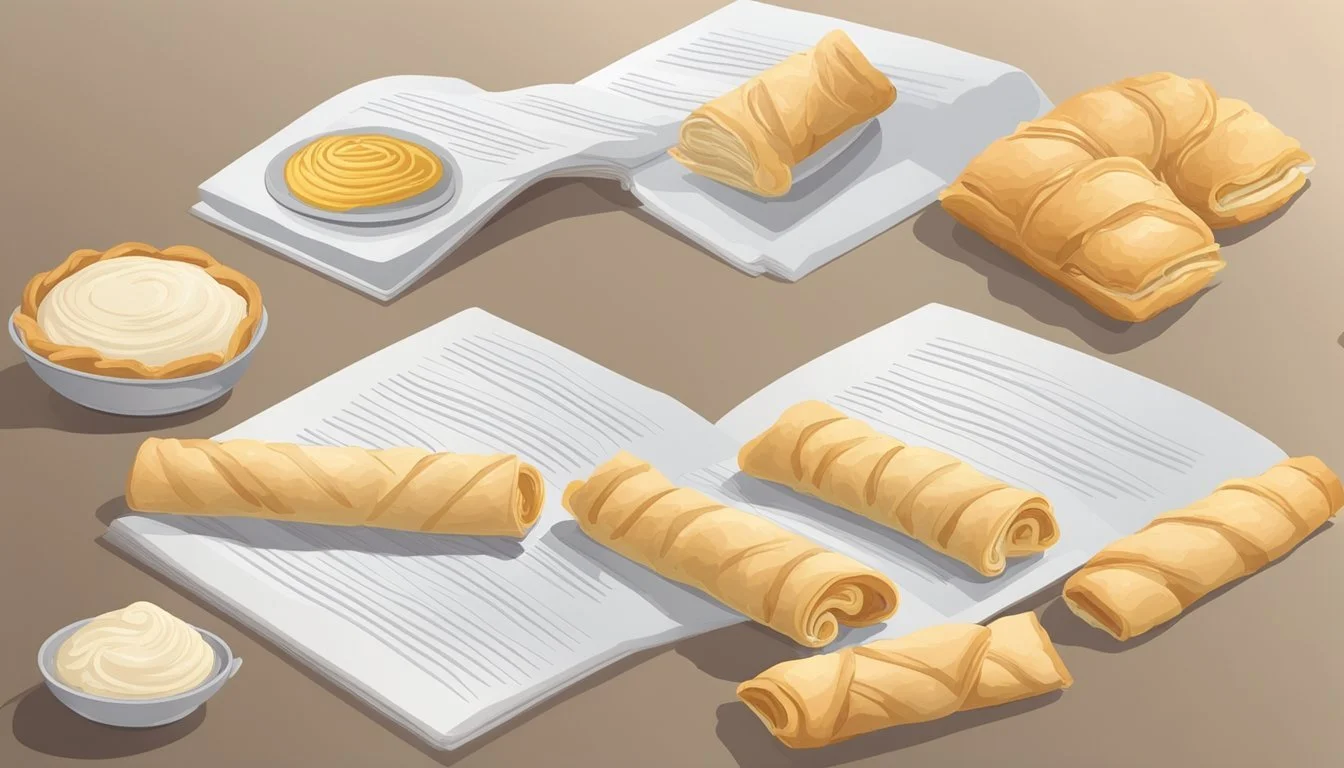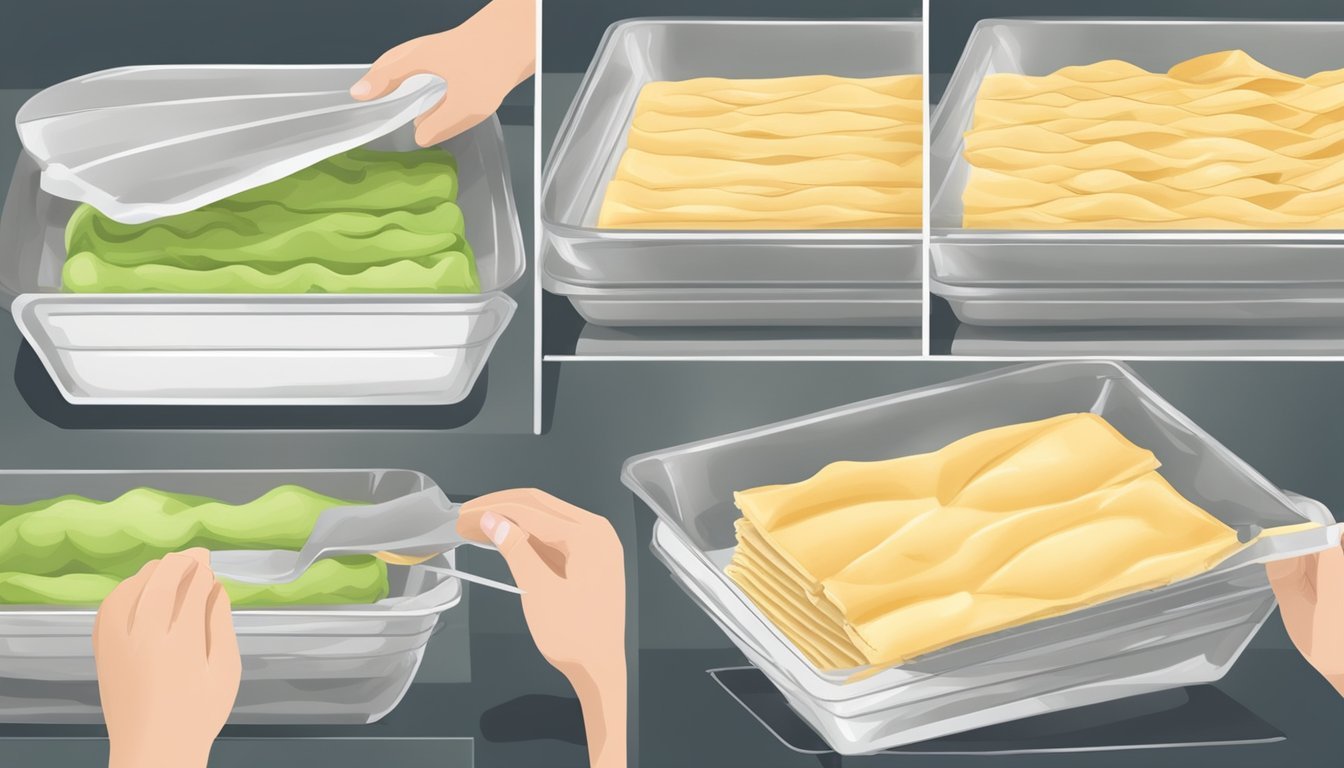How to Substitute Filo Dough for Puff Pastry
A Seamless Baking Guide
When it comes to flaky and tender pastries, puff pastry is often the go-to choice for many recipes due to its rich and layered texture. However, there are times when a cook might need to find an alternative, and phyllo dough can be a handy substitute. Phyllo dough, known for its crisp and delicate layers, does not contain the same amount of fat as puff pastry and requires a different handling technique to achieve similar results.
In substituting phyllo for puff pastry, it's important to understand that while both doughs can achieve a layered effect, phyllo is traditionally used in lighter, crispier applications. Phyllo layers are much thinner than the airy, butter (how long does butter last?)-laden layers of puff pastry, but with careful handling and an understanding of each dough's unique properties, phyllo can effectively replace puff pastry in a variety of dishes, from tarts and turnovers to strudels and pastries. To successfully use phyllo as a substitute, bakers often brush each layer with melted butter or oil to help achieve the desired flakiness.
The key to a seamless substitution lies in the cooking technique and the nature of the dish. While phyllo dough may require additional layers compared to puff pastry to mimic the desired volume and texture, adjustments in layering and baking time can help create a dish that is both visually impressive and flavorful. It is also crucial to keep the phyllo dough covered with a damp cloth to prevent drying out, ensuring the final product maintains the characteristic crispness without being too brittle.
Understanding Filo and Puff Pastry
In the world of pastries, filo and puff pastry stand out for their unique textures and culinary applications. One is known for its delicate, crispy layers while the other is celebrated for its rich, flaky structure.
Defining Phyllo Dough
Phyllo dough, also spelled as filo or fillo, is an unleavened dough that originates from Mediterranean cuisine. It consists of very thin sheets that are typically brushed with oil or melted butter before being layered and used in various dishes. The key characteristics of phyllo dough are its thinness and the absence of added fat within the dough itself, which results in a delicate, crispy texture once baked.
Thickness: Extremely thin sheets.
Fat Content: No fat is incorporated between the layers; oil or butter is applied externally.
Texture: Crisp and flaky when cooked.
Defining Puff Pastry
Puff pastry, in contrast, is a type of laminated dough that involves folding butter into the dough multiple times to create numerous layers. As the pastry bakes, the butter melts, producing steam that separates the layers, leading to a light and airy texture. Puff pastry's richness and flaky structure come from this intricate layering, which can consist of hundreds of layers.
Thickness: Varied thickness, generally thicker than phyllo.
Fat Content: High, with butter layered within the dough.
Texture: Light, airy, and flaky when baked.
The difference between the two lies primarily in their preparation and fat content. While puff pastry relies on the lamination process for its pliable texture, phyllo dough's crispness comes from its thin, lean layers being baked to a golden brown.
Characteristics of Filo and Puff Pastry
In exploring how to substitute filo dough for puff pastry, it's important to understand the distinct characteristics of each. They differ in texture, flavor, and preparation, notably in their fat content and lamination process.
Texture and Flavor
Filo Dough:
Texture: Extremely thin sheets that, when layered, bake up to be crisp and delicate.
Flavor: Has a neutral taste, as it contains minimal fat, which allows it to absorb other flavors well.
Puff Pastry:
Texture: Bakes into a light and airy texture with a flaky finish that is tender to the bite.
Flavor: Known for a rich and buttery flavor due to the high butter content used in its preparation.
Fat Content and Lamination
Filo Dough:
Fat Content: Low, with most recipes calling for brushing each layer with melted butter or oil during preparation rather than incorporating it into the dough.
Lamination: Does not involve a lamination process; the sheets remain separate.
Puff Pastry:
Fat Content: High, as butter is integrated into the dough to create its flaky texture.
Lamination: Involves a labor-intensive process of repeatedly folding dough and butter together, forming distinct, thin layers (laminating) that contribute to its characteristic puff and flakiness when baked.
Preparation and Handling Techniques
When substituting filo dough for puff pastry, understanding the preparation and handling techniques for each type of dough is crucial. Proper handling ensures that the dough maintains its quality and textures—filo for its crispiness and puff pastry for its flakiness.
Working with Filo Dough
Filo dough, known for its ultra-thin layers, requires careful handling to prevent tearing. The dough should be gently unrolled on a clean and dry surface after being thawed in the refrigerator for about 7-8 hours or overnight. To prevent drying out, a damp towel can be placed over the sheets that are not currently being used. Here are specific steps for handling filo:
Thaw: Filo dough usually comes frozen and must be thawed completely in the refrigerator before use.
Prepare Work Area: Have a dry surface dusted with a little flour.
Unroll Cautiously: Gently unroll the filo dough onto the prepared surface.
Keep Moist: Cover with a damp cloth while working to keep the dough pliable.
Brush with Butter/Oil: Typically, each filo layer is brushed with melted butter or oil to create crisp layers after baking.
Working with Puff Pastry
Puff pastry, in contrast, is characterized by its high fat content which gives it a rich and flaky texture. Unlike filo, puff pastry has butter incorporated within its layers, leading to its signature rise and "puff" in the oven. Key points in working with puff pastry are:
Thaw Properly: Allow puff pastry to thaw in the refrigerator or on the counter, but it should still be cold when used.
Flour the Surface: Before rolling out puff pastry, lightly dust the surface and rolling pin with flour to prevent sticking and maintain the layering.
Roll Evenly: Roll out the dough evenly, being careful not to press too hard so as not to crush the layers.
Refrigerate Between Steps: If the dough warms up, place it back in the refrigerator to keep the butter firm.
Avoid Stretching: Never pull or stretch puff pastry as this can cause it to lose its ability to rise.
When handling both types of dough, one must remember to work quickly and efficiently to prevent the fat, whether it be butter or oil, from becoming too warm, ensuring optimal texture and performance in recipes such as baklava or other pastry dishes.
Substituting Filo for Puff Pastry
When substituting filo dough for puff pastry, it's essential to account for textures and flavors. Filo dough, due to its crispier nature when baked and absence of butter layers, offers a different experience than the rich, flaky texture of puff pastry.
General Tips for Substitution
Layering: To mimic the flakiness of puff pastry, layer multiple sheets of filo, brushing each with melted butter or oil.
Thickness: Adjust the number of filo layers to match the thickness of the desired puff pastry in the recipe.
Baking Temperature: Filo dough generally requires a lower baking temperature, around 325°F to 350°F, to avoid burning the thin sheets.
Handling Care: Filo dough is delicate and dries out quickly; keep the sheets under a damp towel when not in use.
Puff Pastry Attribute Filo Dough Adjustment Buttery layers Brushing between filo sheets with butter/oil Thickness Increase filo layers Baking Temperature Decrease filo pastry's usual baking temperature Handling Work quickly, keep unused filo covered
Application in Specific Dishes
Spanakopita: Traditionally made with filo dough, it requires careful layering and buttering to create its signature crispy texture.
Samosas: While typically enclosed with a thicker pastry, filo can be substituted for a lighter, crispy outcome. Double up filo sheets to increase durability.
Deserts and Appetizers: Whether one's creating tarts, turnovers, or other small bites, use filo for a crunchier edge. Adjust filling amounts as filo is thinner than standard puff pastry.
Savory Dishes: For savory pies or toppings on dishes like pot pies, filo can be an excellent substitute by adding a unique, light crispness to the meal.
Remember that while filo can replace puff pastry, the results will differ in texture and may require slight modifications to the original puff pastry recipe to achieve the best results.
Recipes and Applications
When substituting phyllo dough for puff pastry, chefs must consider the texture and application of the original recipe. Phyllo dough, being thinner and less rich than puff pastry, is best suited for dishes where a crispy texture is desired. Adjustments may be required in terms of buttering or oiling the layers and baking time to achieve satisfactory results.
Savory Dishes
Phyllo dough excels in savory applications, offering a light and crispy contrast to the rich fillings. Savory tarts like a spinach and feta tart, akin to Greek Spanakopita, are prime examples where phyllo can replace puff pastry while maintaining the dish's integrity. Similarly, phyllo is a good choice for creating Middle Eastern savories such as samosas or turnovers with savory meat and vegetable fillings.
Turnovers: They can be filled with seasoned meat like beef or chicken, typically mixed with vegetables.
Savory Tarts: Phyllo layers can be shaped into tart cases and filled with quiche (What wine goes well with quiche?) -like mixtures or vegetable medleys.
To use phyllo in dishes traditionally made with puff pastry, such as beef Wellington, (What wine goes well with beef Wellington?) structural changes must be considered since phyllo doesn't have the same leavening and may not wrap around fillings in the same way.
Sweet Dishes
In the realm of desserts, phyllo dough is an adept substitute that offers a delightful crunch. Popular baked goods, including pastries and tarts, can be reimagined with phyllo layers for a lighter bite. When used in place of puff pastry for a croissant- style treat, phyllo provides a unique texture but lacks the traditional buttery layers—a compromise for the sake of variation and a crispier finish.
Sweet Pies and Tarts: Layers of phyllo can hold sweet fruit fillings, such as apples or berries, for a pie or tart.
For pastries that depend on puff pastry's rise, like Danishes, phyllo will create a different but still satisfying experience. Light brushing of melted butter or syrup between layers will add to the flavor and aid in the golden coloring upon baking.
Nutritional Considerations
When substituting phyllo dough for puff pastry, one should consider their respective caloric and nutritional content, as it can have significant implications for those mindful of their dietary intake.
Caloric and Nutritional Content
Phyllo dough is generally lower in calories and fat compared to puff pastry. Phyllo dough sheets are thin and do not contain the high amounts of butter that puff pastry does. Here's a comparative breakdown:
Calories: A single sheet of phyllo dough typically contains about 30-40 calories, whereas the equivalent amount of puff pastry could contain over 100 calories due to the higher butter content.
Fat Content: Puff pastry is notably richer with a higher fat content, given that its layers are made with butter. Phyllo dough, on the other hand, is often used with minimal oil or butter brushed between the layers, significantly reducing its total fat content.
Incorporating phyllo dough as a substitute can suit those on a Mediterranean diet, which emphasizes lower saturated fat intake and encourages the use of healthier fats such as olive oil. When phyllo is properly prepared with olive oil, it aligns well with the Mediterranean dietary patterns.
Remember that while phyllo might offer a lower-calorie and lower-fat alternative, it should still be enjoyed in moderation as part of a balanced and varied diet to maintain overall health.
Customizing Filo-Based Recipes
When substituting filo dough for puff pastry, one's approach to customization is crucial for achieving the desired flavor and texture. Careful consideration of additional ingredients and flavors can elevate the final dish.
Adding Flavor and Texture
To enhance the taste and texture of filo-based recipes, incorporating layers of flavor as one builds the filo pastry is key. Ingredients like melted butter or olive oil brushed between filo sheets add richness and crispness. For a sweet application, a sprinkling of cinnamon and honey between the layers can impart a delightful spiciness and stickiness, respectively. In savory dishes, a combination of salt and pepper can provide a simple flavor enhancement. To add more complexity, finely chopped walnuts or crumbles of feta cheese layered between the filo can offer both a nutty depth and a tangy sharpness.
Sweet filo customization for desserts:
Brush with a mixture of cinnamon and honey.
Add crushed walnuts for a nutty crunch.
Savory filo customization for entrees:
Sprinkle with salt and pepper for basic seasoning.
Layer with crumbled feta cheese to infuse a briny tang.
Alternative Ingredients
In some recipes, replacing certain ingredients with alternatives suited to filo dough's properties can greatly improve the outcome. For instance, using a homemade filling enriched with eggs creates a stable structure that complements the thin layers of filo. If puff pastry's fat content is a concern, substituting with olive oil can be a healthier alternative that still provides moisture and flavor. In cases where a lighter touch is preferred, a simple egg wash before baking can give the filo a golden finish without the heaviness of butter.
Homemade fillings:
Use eggs for binding in quiches or custard-based desserts.
Healthier fat alternatives:
Olive oil as a brush-on for layers or mixed into fillings.
Remember to adjust cooking times and temperatures accordingly when making substitutions, as filo dough may bake quicker and at a lower temperature than puff pastry. Use of olive oil or butter layers will influence how flaky and golden the filo turns after baking. The additions of different seasonings and layers will also impact the final taste and mouthfeel of the dish.
Conclusion
When substituting filo dough for puff pastry, chefs should consider the textural differences. Filo dough offers a crispier finish, while puff pastry is prized for its flaky crust. The richness of puff pastry, derived from the high butter content, is not naturally present in filo. Therefore, layers of filo should be buttered to mimic this quality.
In terms of French cuisine, which often calls for puff pastry, filo can be a suitable alternative with proper technique. While filo lacks the loftiness of leavened puff pastry, it can still create an impressive presentation when layered correctly.
Key Considerations for Substitution:
Textural outcome: Expect a crispier texture with filo.
Flavor profile: Achieve comparable richness by adding butter between filo sheets.
Application: Ideal for both sweet and savory dishes.
Aesthetics: Layering filo may not produce the same puff but can still offer an elegant visual appeal.
Remember to adjust baking times and temperatures, as filo and puff pastry do not bake identically. With thoughtful application, filo can be a satisfactory stand-in for puff pastry, allowing cooks to maintain the integrity of their dish.







